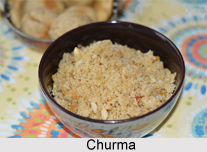 Churma is a great accompaniment to the trio dish "Dal-Baati-Churma". Dal-Baati is incomplete without the quintessential "Churma" in the traditional dish of Rajasthani Cuisine. Churma is made using coarsely ground wheat flour, besan or maize flour. Churma is prepared with wheat dough balls which are baked in oven and then reduced to crumbs to make this scrumptious sweet. The most celebrated of all is the wheat flour Churma that can also be is shaped into Laddus. It is sometimes difficult to find coarsely ground wheat flour easily. The semolina adds that extra bite to the Churma, greatly improving the texture of the whole wheat flour.
Churma is a great accompaniment to the trio dish "Dal-Baati-Churma". Dal-Baati is incomplete without the quintessential "Churma" in the traditional dish of Rajasthani Cuisine. Churma is made using coarsely ground wheat flour, besan or maize flour. Churma is prepared with wheat dough balls which are baked in oven and then reduced to crumbs to make this scrumptious sweet. The most celebrated of all is the wheat flour Churma that can also be is shaped into Laddus. It is sometimes difficult to find coarsely ground wheat flour easily. The semolina adds that extra bite to the Churma, greatly improving the texture of the whole wheat flour.
Preparation of Churma
Knead the wheat flour into a soft and pliable dough and form them into dough balls. Fry the balls in ghee or bake them into Baatis. Later Baati crumbs are roasted in ghee and desiccated coconut, dried nuts and cardamom powder are added to perk up the flavors. Ghee is added in abundance to all the Rajasthani dishes and Churma is no exception at all. More the ghee the softer the Churma turns out to be.
Ingredients:
•Whole Wheat Flour - 2 cups
•Pure Ghee - 1/2 cup, melted
•Semolina - 4 tbsp
•Powdered Sugar - 3/4 cup
•Green Cardamom Powder - 1/4 tsp
•Cashew nuts - 10, finely chopped
•Almonds - 10, finely chopped
•Raisins - 10
•Desiccated Coconut - 1/2 cup
•Milk as required
Method:
•In a bowl, mix whole wheat flour and semolina.
•Add half cup of ghee to it and mix well.
•Add milk as required and knead into a stiff dough.
•Divide the dough into 12 lemon sized balls.
•In a wok, heat sufficient ghee and deep fry the balls on medium heat, till they are golden brown in colour from all the sides.
•Drain and place on an absorbent paper and cool.
•Drain the excess oil and allow it to cool.
•In a mixer, grind the balls to a coarse mixture.
•Add powdered sugar, dried coconut, cardamom powder, cashew nuts, almonds and raisins and mix.
•Store in an air-tight container. It can also be stored for 2 weeks.
•Serve Churma with ghee on top along with Dal Baati.




















